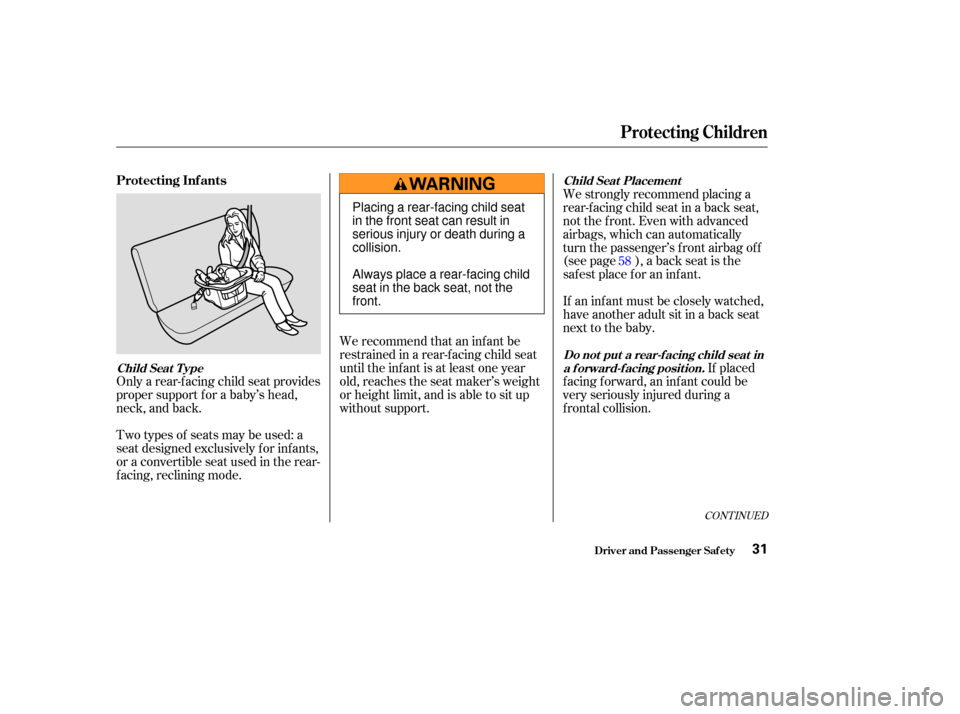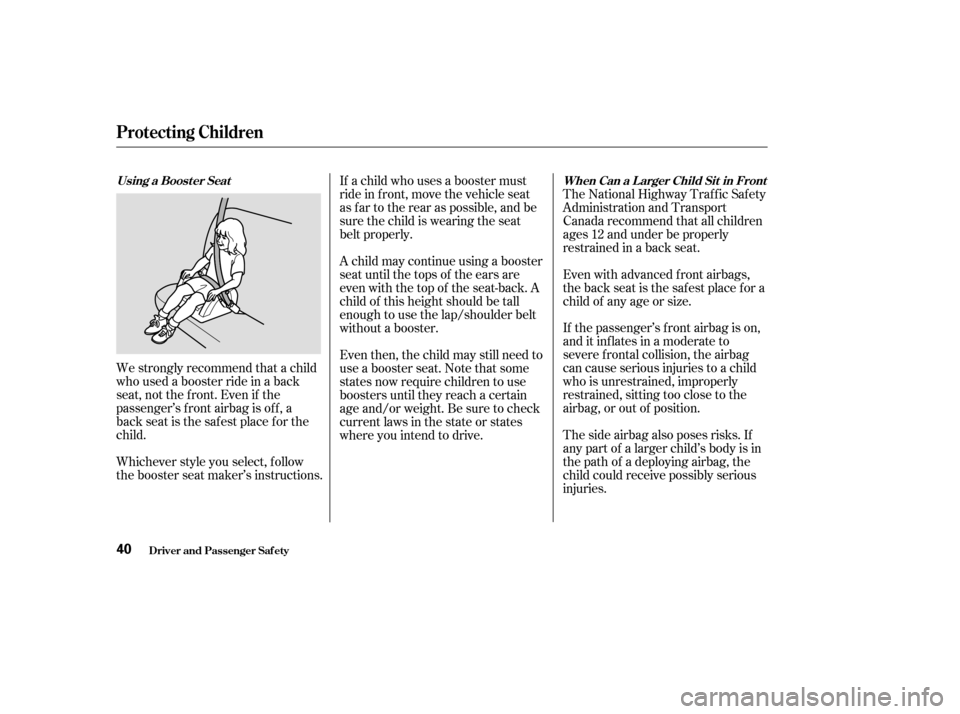ECO mode Acura MDX 2003 Owner's Manua
[x] Cancel search | Manufacturer: ACURA, Model Year: 2003, Model line: MDX, Model: Acura MDX 2003Pages: 420, PDF Size: 5.46 MB
Page 2 of 420

T his Owner’s Manual should be considered
a permanent part of the vehicle, and should
remain with the vehicle when it is sold.
T his Owner’s Manual covers all models of
theMDX.Youmayfinddescriptionsof
equipment and f eatures that are not on your
particular model.
T he inf ormation and specif ications included
in this publication were in ef f ect at the time
of approval f or printing. Honda Motor Co.,
Ltd. reserves the right, however, to
discontinue or change specif ications or
design at any time without notice and
without incurring any obligation whatsoever.
Owner’s Identif ication
POUR CLIENTS CANADIEN
A VIS IMPORT A NT : Si vous avez
besoin d’un Manuel du Conduct eur
en f rançais, veuillez demander à
votreconcessionnairede
commander le numéro de pièce
33S3V820
OWNER
ADDRESS
V. I. N.
DELIVERY DATE
DEALER NAMEDEALER NO.
ADDRESS
OWNER’S SIGNATURE
DEALER’S SIGNATURE
STREET
CITY STATE/PROVINCE ZIP CODE/
POSTAL CODE
(Date sold to original retail purchaser)
STREET
CITY STATE/PROVINCE ZIP CODE/
POSTAL CODE
Page 10 of 420

You’ll f ind many saf ety
recommendations throughout this
section, and throughout this manual.
Therecommendationsonthispage
are the ones we consider to be the
most important.Excessive speed is a major f actor in
crash injuries and deaths. Generally,
the higher the speed the greater the
risk, but serious accidents can also
occur at lower speeds. Never drive
f aster than is saf e f or current
conditions, regardless of the
maximum speed posted.
While airbags can save lives, they
can cause serious or fatal injuries to
occupants who sit too close to them,
or are not properly restrained.
Inf ants, young children, and short
adults are at the greatest risk. Be
sure to f ollow all instructions and
warnings in this manual. (See page
.)
Having a tire blowout or a
mechanical f ailure can be extremely
hazardous. To reduce the possibility
of such problems, check your tire
pressures and condition f requently,
and perform all regularly scheduled
maintenance. (See page .)
Children are saf est when they are
properly restrained in a back seat,
notthefrontseat.Achildwhoistoo
smallforaseatbeltmustbeproperly
restrained in a child saf ety seat. (See
page .) Alcohol and driving don’t mix. Even
one drink can reduce your ability to
respond to changing conditions, and
your reaction time gets worse with
every additional drink. So don’t drink
and drive, and don’t let your f riends
drink and drive, either.
A seat belt is your best protection in
all types of collisions. Airbags
supplement seat belts, but airbags
are designed to inf late only in a
moderate to severe f rontal collision.
So even though your vehicle is
equipped with airbags, make sure
you and your passengers always
wear your seat belts, and wear them
properly. (See page .)
15 9
21 296
Driver and Passenger Saf ety
Important Saf ety Precautions
Always Wear Your Seat BeltBe Aware of Airbag Hazards Control Your Speed
K eep Your Vehicle in Saf e
Condition
Restrain All Children Don’t Drink and Drive
6
Page 27 of 420

Front airbags have been designed to
help protect adults in a moderate to
severe f rontal collision. To do this,
the passenger’s f ront airbag is quite
large, and it can inflate with enough
f orce to cause very serious injuries.With an advanced airbag system, the
f ront passenger’s airbag is turned of f
if sensors detect a total weight of
less than about 65 lbs (30 kg) in the
seat, and the ‘‘Passenger Airbag
Cutof f ’’ indicator is turned on. (See
page f or additional inf ormation on
how the passenger’s airbag works.)
Even if the passenger’s f ront airbag
is turned of f , we strongly
recommend that inf ants, small
children, and larger children ride
properly restrained in a back seat
wheretheywillbesafer.
To help prevent airbag-caused
deaths and injuries to children, this
vehicle has an advanced airbag
system. 58
The Passenger’s Front Airbag
Can Pose Serious Risks
Protecting Children
Driver and Passenger Saf ety23
Page 32 of 420

Due to variations in the design of
child seats, vehicle seats, and seat
belts, all child seats will not f it all
vehicle seating positions.
However, Acura is conf ident that one
or more child seat models can f it and
be properly installed in all
recommended seating positions in
your vehicle.Bef ore purchasing a child seat, we
recommend that parents test the
child seat in the specif ic vehicle
seating position (or positions) where
they intend to use the seat. If a
previously purchased child seat does
not f it, you may need to buy a
different one that will fit.
Your vehicle has lower anchors
installed f or use with LATCH
(Lower Anchors and Tethers f or
Children) - compatible child seats.
For more inf ormation, see page .
44
T he child seat should f it the
vehicle seat ing posit ion (orposit ions) where it will be used.
3.
Protecting Children
Driver and Passenger Saf ety28
Page 35 of 420

Only a rear-f acing child seat provides
proper support f or a baby’s head,
neck, and back.
Two types of seats may be used: a
seat designed exclusively f or inf ants,
or a convertible seat used in the rear-
f acing, reclining mode.We strongly recommend placing a
rear-facing child seat in a back seat,
not the front. Even with advanced
airbags, which can automatically
turn the passenger’s f ront airbag of f
(see page ), a back seat is the
saf est place f or an inf ant.
If an inf ant must be closely watched,
have another adult sit in a back seat
next to the baby.
If placed
f acing f orward, an inf ant could be
very seriously injured during a
f rontal collision.
We recommend that an inf ant be
restrained in a rear-f acing child seat
until the inf ant is at least one year
old, reaches the seat maker’s weight
or height limit, and is able to sit up
without support. 58
CONT INUED
Protecting Inf ants
Child Seat T ype Child Seat Placement
Do not put a rear-f acing child seat ina f orward-f acing position.
Protecting Children
Driver and Passenger Saf ety31
Placing a rear-facing child seat
in the front seat can result in
serious injury or death during a
collision.
Always place a rear-facing child
seat in the back seat, not the
front.
Page 44 of 420

We strongly recommend that a child
whousedaboosterrideinaback
seat,notthefront.Evenif the
passenger’s f ront airbag is of f , a
back seat is the safest place for the
child.
Whichever style you select, f ollow
the booster seat maker’s instructions.If a child who uses a booster must
ride in f ront, move the vehicle seat
as far to the rear as possible, and be
sure the child is wearing the seat
belt properly.
The National Highway Traffic Safety
Administration and Transport
Canada recommend that all children
ages 12 and under be properly
restrained in a back seat.
The side airbag also poses risks. If
any part of a larger child’s body is in
the path of a deploying airbag, the
child could receive possibly serious
injuries. If the passenger’s f ront airbag is on,
and it inflates in a moderate to
severe f rontal collision, the airbag
can cause serious injuries to a child
who is unrestrained, improperly
restrained, sitting too close to the
airbag, or out of position. Even with advanced front airbags,
the back seat is the safest place for a
child of any age or size.
A child may continue using a booster
seat until the tops of the ears are
even with the top of the seat-back. A
child of this height should be tall
enough to use the lap/shoulder belt
without a booster.
Even then, the child may still need to
use a booster seat. Note that some
states now require children to use
boosters until they reach a certain
ageand/orweight.Besuretocheck
current laws in the state or states
where you intend to drive.
Using a Booster Seat
When Can a Larger Child Sit in Front
Protecting Children
Driver and Passenger Saf ety40
Page 54 of 420

Your Supplemental Restraint System
(SRS) includes:Automatic seat belt tensioners
(see page ). Two f ront airbags. The driver’s
airbag is stored in the center of
the steering wheel; the f ront
passenger’sairbagisstoredinthe
dashboard. Both are marked ‘‘SRS
AIRBAG.’’
Sensors that can detect a
moderate to severe frontal
collision.
A sophisticated electronic system
that continually monitors and
records inf ormation about the
sensors, the control unit, the
airbag activators, and driver and
passenger seat belt use when the
ignition is ON (II). 48
SRS Components
Additional Inf ormation About Your Airbags
Driver and Passenger Saf ety50
(5)
(8)
(3)
(7)
(4)
(4) (6)
(5)(7)(2)
(9)
(9) (10)
(8)(1)
(1) Driver’s Airbag
(2) Front Passenger’s Airbag
(3) Control Unit
(4) Seat Belt Tensioners
(5) Side Airbags
(6) Driver’s Seat Position Sensor
(7) Front Passenger’s Weight Sensors
(8) Front Sensor
(9) Side Impact Sensors
(10) Passenger Airbag Cutoff Indicator
Page 56 of 420

Af ter inf lating, the f ront airbags
immediately def late, so they won’t
interf ere with the driver’s visibility,
or the ability to steer or operate
other controls.
The total time for inflation and
def lation is approximately one-tenth
of a second, so f ast that most
occupants are not aware that the
airbags deployed until they see them
lying in their laps.
Since both airbags use the same
sensors, both airbags normally
inf late at the same time. However, it
is possible f or only one airbag to
inf late.
This can occur when the severity of
a collision is at the margin, or
threshold, that determines whether
or not the airbags will deploy. In
such cases, the seat belt will provide
suf f icient protection, and the
supplemental protection of f ered by
the airbag would be minimal.
During a f rontal crash, your seat
belts help restrain your lower body
and torso. Your airbag provides a
cushion to help restrain and protect
your head and chest. If you ever have a moderate to
severe f rontal collision, the sensors
will detect the vehicle’s rapid
deceleration. If the rate of
deceleration is high enough, the
control unit will instantly inf late the
f ront airbags.
Additional Inf ormation About Your Airbags
Driver and Passenger Saf ety52
Page 67 of 420

These labels are in the locations
shown. They warn you of potential
hazards that could cause serious
injury. Read these labels caref ully.
If a label comes of f or becomes hard
to read, contact your Acura dealer
f or a replacement.U.S. models onlyU.S. models
Canadian models
Saf ety L abels
Driver and Passenger Saf ety63
RADIATOR CAP SUN VISOR
HOOD DASHBOARD
BATTERY LABEL
Page 76 of 420

This light normally comes on f or a
f ew seconds when you turn the
ignition switch ON (II). If this light
comes on at any other time, there is
a problem in the 4WD system. Take
the vehicle to your dealer to have it
checked.
This indicator monitors the
temperature of the automatic
transmission f luid. The indicator
should come on f or a f ew seconds
when you turn the ignition switch
ON (II). If it comes on while driving,
it indicates the transmission f luid
temperature is too high. Pull to the
side of the road when it is saf e, shif t
to Park, and let the engine idle until
the indicator goes out.
If the indicator blinks while driving,
pull to the side of the road when it is
saf e, shif t to Park, and let the engine
idle until the indicator goes out.
This indicator reminds you that the
exterior lights are on. It comes on
when the light switch is in either the
or position. This indicator
will come on when the light switch is
in AUTO and the lights turn on
automatically. If you turn the ignition
switch to ACCESSORY (I) or LOCK
(0) without turning of f the light
switch, this indicator will remain on.
A reminder chime will also sound
when you open the driver’s door.On cars with automatic lighting (see
page ) 80
Indicator L ights
Inst rument s and Cont rols
VTM-4 Indicator
A/T Temperature
Indicator
Lights On Indicator
(U.S. models only)
72
Continuing to drive with the A/T
Temperature indicator lit may cause
serious damage to the transmission. Continuing to drive with the VTM-4
indicator blinking may cause serious
damage to the system.